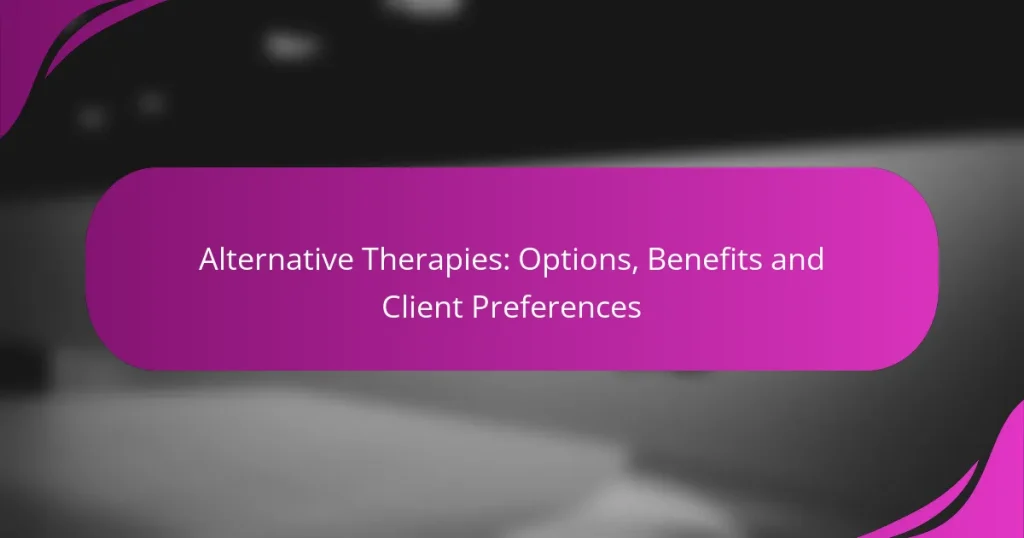Alternative therapies have gained popularity in the United States as individuals seek non-invasive options for managing health issues. With a variety of treatments available, such as acupuncture, chiropractic care, and massage therapy, these approaches can provide benefits like pain relief and improved mental well-being. Client preferences, influenced by personal values and healthcare recommendations, play a crucial role in the selection of these therapies.

What alternative therapies are popular in the United States?
In the United States, several alternative therapies are widely used, including acupuncture, chiropractic care, massage therapy, homeopathy, and herbal medicine. These therapies often appeal to individuals seeking non-invasive treatments for various health issues.
Acupuncture
Acupuncture involves inserting thin needles into specific points on the body to promote healing and alleviate pain. This ancient practice is based on the belief that stimulating these points can balance the body’s energy, or “qi.”
Many people use acupuncture for conditions such as chronic pain, migraines, and stress relief. Sessions typically last 30 to 60 minutes, and patients may require multiple treatments for optimal results.
Chiropractic care
Chiropractic care focuses on diagnosing and treating musculoskeletal disorders, particularly those related to the spine. Chiropractors use manual manipulation techniques to adjust the spine and improve alignment.
This therapy is often sought for back pain, neck pain, and headaches. Patients may experience immediate relief, but ongoing sessions are usually recommended to maintain spinal health and prevent future issues.
Massage therapy
Massage therapy involves manipulating the body’s soft tissues to relieve tension, improve circulation, and promote relaxation. Various techniques, such as Swedish or deep tissue massage, cater to different needs and preferences.
Many individuals turn to massage therapy for stress reduction, muscle recovery, and pain management. Sessions can range from 30 minutes to two hours, depending on the desired outcome and techniques used.
Homeopathy
Homeopathy is a system of medicine that uses highly diluted substances to trigger the body’s natural healing processes. Practitioners select remedies based on the individual’s symptoms and overall health.
Commonly used for conditions like allergies, colds, and digestive issues, homeopathy emphasizes personalized treatment. However, it is essential to consult with a qualified practitioner to ensure safe and effective use.
Herbal medicine
Herbal medicine utilizes plants and plant extracts for therapeutic purposes. This approach can involve teas, capsules, tinctures, or topical applications to address various health concerns.
Many people use herbal remedies for issues such as inflammation, digestive problems, and immune support. It’s crucial to research herbs thoroughly and consult with a healthcare provider, as some may interact with prescription medications or have side effects.

What are the benefits of alternative therapies?
Alternative therapies offer a range of benefits, including pain relief, stress reduction, improved mental health, and enhanced overall well-being. These therapies can complement traditional medical treatments and provide individuals with additional options for managing their health.
Pain relief
Many alternative therapies, such as acupuncture, chiropractic care, and massage therapy, are recognized for their effectiveness in alleviating pain. These methods often focus on addressing the root causes of discomfort rather than just masking symptoms.
For instance, acupuncture may help reduce chronic pain by stimulating specific points on the body, while massage therapy can relieve muscle tension and improve circulation. Individuals seeking pain relief should consider consulting with a qualified practitioner to explore the best options for their specific conditions.
Stress reduction
Alternative therapies are widely used for stress reduction, with techniques like yoga, meditation, and aromatherapy showing significant benefits. These practices promote relaxation and mindfulness, helping individuals manage daily stressors more effectively.
For example, yoga combines physical postures with breathing exercises, which can lower cortisol levels and enhance mental clarity. Incorporating these therapies into a regular routine can lead to long-term improvements in stress management.
Improved mental health
Alternative therapies can play a crucial role in improving mental health by providing holistic approaches to emotional well-being. Techniques such as mindfulness meditation, art therapy, and herbal remedies have been shown to support mental health and alleviate symptoms of anxiety and depression.
Engaging in creative therapies, like art or music therapy, allows individuals to express their emotions in a safe environment, which can lead to increased self-awareness and healing. It is essential to choose therapies that resonate personally for the best outcomes.
Enhanced well-being
Overall well-being can be significantly enhanced through alternative therapies that focus on the mind-body connection. Practices such as tai chi, reiki, and nutritional counseling promote a balanced lifestyle and foster a sense of harmony.
For example, tai chi combines gentle movements with deep breathing, which can improve physical fitness and mental clarity. Individuals interested in enhancing their well-being should consider a comprehensive approach that includes physical, emotional, and nutritional aspects of health.

How do clients choose alternative therapies?
Clients typically choose alternative therapies based on personal preferences, recommendations from healthcare providers, and research or reviews. These factors influence their decisions, helping them find therapies that align with their values and health needs.
Personal preferences
Personal preferences play a crucial role in selecting alternative therapies. Clients often consider their beliefs about health, wellness, and the types of treatments they feel comfortable with, such as herbal remedies, acupuncture, or yoga.
For example, someone who values natural approaches may lean towards herbal supplements, while another person might prefer hands-on therapies like massage. Understanding one’s own preferences can lead to more satisfying and effective treatment experiences.
Recommendations from healthcare providers
Healthcare providers significantly influence clients’ choices in alternative therapies. Many clients seek guidance from their doctors or specialists, who may suggest specific therapies based on their medical history and current health conditions.
For instance, a doctor might recommend acupuncture for pain management or suggest dietary changes supported by nutritional therapy. It’s essential for clients to discuss their interests in alternative therapies with their healthcare providers to ensure safety and compatibility with existing treatments.
Research and reviews
Clients often turn to research and reviews to inform their choices regarding alternative therapies. They may look for studies, articles, or testimonials that highlight the effectiveness and safety of various treatments.
Online platforms and community forums can provide valuable insights, but clients should critically evaluate the credibility of sources. Checking for peer-reviewed studies or reputable health websites can help clients make informed decisions about which therapies to pursue.

What factors influence client preferences for alternative therapies?
Client preferences for alternative therapies are shaped by a variety of factors, including cultural beliefs, accessibility, and cost. Understanding these influences can help practitioners better meet the needs of their clients.
Cultural beliefs
Cultural beliefs play a significant role in shaping how individuals perceive and choose alternative therapies. For instance, some cultures may prioritize holistic approaches that emphasize the mind-body connection, while others may favor traditional medical practices. This can affect not only the types of therapies clients are open to but also their willingness to engage with practitioners.
Practitioners should be aware of the cultural backgrounds of their clients and consider integrating culturally relevant practices into their offerings. This can enhance trust and improve client satisfaction.
Accessibility and availability
The accessibility and availability of alternative therapies significantly influence client preferences. Clients are more likely to choose therapies that are easily accessible, whether through local practitioners, online options, or community resources. Geographic location can limit choices, especially in rural areas where alternative therapies may not be widely offered.
To improve accessibility, practitioners can consider offering virtual consultations or workshops. This can help reach clients who may not have local access to certain therapies, broadening their client base.
Cost considerations
Cost is a critical factor in client preferences for alternative therapies. Many clients seek affordable options, and the price of treatments can vary widely. Some therapies may not be covered by insurance, which can deter clients from pursuing them.
Practitioners should provide transparent pricing and consider offering sliding scale fees or package deals to make therapies more accessible. Communicating the potential long-term benefits of these therapies can also help justify the costs to clients.

What are the prerequisites for starting alternative therapies?
Before starting alternative therapies, individuals should consider their health status, consult with healthcare professionals, and research the specific therapy options available. Understanding personal goals and potential risks is crucial for an informed decision.
Understanding Your Health Status
Assessing your health status is essential before engaging in alternative therapies. This includes identifying any existing medical conditions, medications you are currently taking, and overall physical and mental well-being. A thorough self-assessment can help determine which therapies may be beneficial or contraindicated.
For example, individuals with chronic conditions like diabetes or heart disease should be cautious and seek guidance from healthcare providers to avoid complications. Keeping a health journal can also be helpful in tracking symptoms and responses to various therapies.
Consulting Healthcare Professionals
Consulting with healthcare professionals is a critical step in starting alternative therapies. A doctor or qualified practitioner can provide insights into the safety and efficacy of specific therapies based on your health profile. They can also help identify any potential interactions with conventional treatments.
Consider asking questions about the therapy’s evidence base, expected outcomes, and any necessary lifestyle changes. This dialogue can empower you to make informed choices that align with your health goals.
Researching Therapy Options
Researching various alternative therapy options is vital to find the best fit for your needs. This includes exploring modalities such as acupuncture, herbal medicine, or yoga, and understanding their principles, techniques, and potential benefits. Each therapy has unique characteristics that may appeal to different individuals.
Utilizing reputable sources, such as academic articles or professional organizations, can provide valuable information. Additionally, reading client testimonials and reviews can offer insights into the experiences of others who have pursued similar therapies.
Setting Personal Goals
Setting clear personal goals is important when starting alternative therapies. Define what you hope to achieve, whether it’s pain relief, stress reduction, or improved overall wellness. Having specific objectives can guide your therapy choices and help measure progress over time.
For instance, if your goal is to manage anxiety, you might consider therapies like mindfulness meditation or aromatherapy. Regularly revisiting and adjusting your goals can enhance your commitment and satisfaction with the therapy process.


